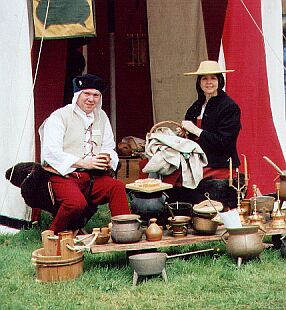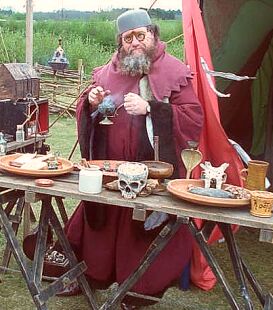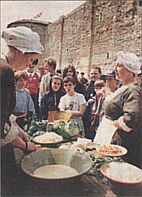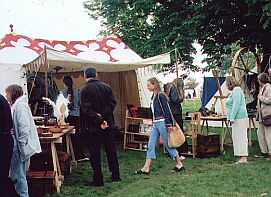The
Oyster fayre
Having become accustomed
to Colchester's history fairs as
major public events in
the Eastern Counties, in Summer 2003
we shall mount a fair
with a name that will easily be remembered
and recognizable as an
event that could only have come
from Colchester, the home
of the Native oyster.
On June 14th & 15th
we intend to mount a full medieval fair,
with many of the peripheral
activities that this major annual event
would have offered. It
will remember the time when folk
from the countryside and
neighbouring villages
would travel to the ‘Big
Fair’ in the town.
View
the Handbill
We shall set our fair in
the period mid-15th to mid-16th century.
We shall not be able to
offer the traditional street fair in the town,
due to the limitations
of the High Street, so we shall
gather together on Lower
Castle Park all the colour and activities
of an historic, traditional
country fair that we can muster.

Crucial to such a past
gathering would have been the Market.
Here we will show avenues
of stalls selling the everyday items
along with less common
goods that our ancestors
would have needed to see
them through the coming year.
Anything from a pin to
a full suit of armour may well have been on sale.
A great many pitches using
authentic tentage or booths will be there.
Each trader will have been
carefully vetted, so that only true merchandise suitable for the traditional
market is provided. Maybe
a great wheel for spinning,
or linen for making clothes, new bowls for cooking, or leather to repair
shoes. All will be there and on sale.
Perishable goods such as
grain, fruit, vegetables and meat would normally have been purchased at
weekly markets, so should not
be expected at the Oyster
Fayre. There will however be a large tented area on the periphery of the
fair, where traders selling 21st century
artefacts or with modern
booths can pitch their stalls,
alongside local and regional
history societies.
Of course no fair is complete
without side-shows.
We hope to have a good
variety of fair games for all to play,
some with prizes, so roll
up and ‘Splat the rat’.
The Colchester History
Fayre Trust, over the past three fairs, concentrated on the military aspect
of the chosen theme for its spectacular on both days. We intend this time
to withdraw from large battle scenarios, owing to the cost involved in
staging such displays and the considerable work involved in making the
site safe for the public.
Therefore, at the Oyster
Fayre, there will be no display of
massed troops, but instead,
a tourney ring or combat area.
Here we can stage hand-to-hand
armed combat,
demonstrating the use
of various weapons and armour,
with a referee to ensure
that things don't get out of hand.
Visitors will have the
opportunity to try on armour
and feel the weapons,
such as bill and poleaxe, at first hand.
The true weight of a mail
shirt never ceases to amaze the public.
During the weekend we hope
to introduce Oyster Wrestling.
Tussling was always common
at fairs but we will make life difficult for our combatants by greasing
then down in Goose fat before they fight
for the honour of being
‘Champion of the Fayre’. We may even have combatants tied together to make
the bouts a little more entertaining.
Everyone went to the fair,
and let's face it, there were not many other opportunities for entertainment
and socializing in those meaner times. So, expect to see some strange fellows
or hear unfamiliar cries.
Market cries and announcements
from the Reeves are intended to be all-pervading. Itinerants and beggars
may demand food or alms, or a wandering trader may ask you to stand awhile
as he shows his wares.
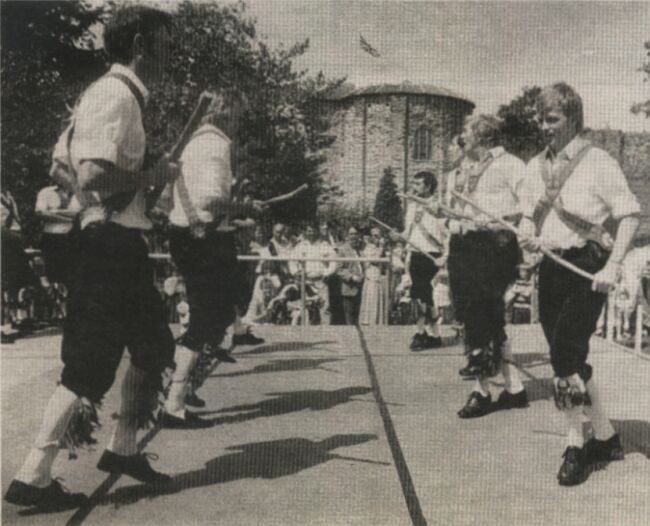
Dance and drama will be
heavily featured. Demonstrations of
‘common’ dance will be
programmed throughout the day.
The public will be invited
to participate in the simpler dances,
with instruction in the
trickier ones available. An area for players will be assigned, where a
large group of Mummers can perform their plays. There will be other performing
areas where individuals can story-tell
or recite poems, and players
can show dramatic interludes.
Here again we may have
singers, jugglers, tumblers and stilt walkers.
One way of ‘cocking a snook’
at your betters was
to hide behind a puppet.
We will have two puppet troupes
performing at various
times during the day.
Archery was all-important.
Until the middle of the C16th it was
the main weapon of combat
and also of sport. All men of fighting age were expected to practice at
the butts, once a week, usually after church on Sunday. So a ‘close’ will
be set up, with butts for practice
and competition. Here
again the public will be invited to ‘have a go’.
Demonstrators and instructors
will be on hand to ensure
a safe representation
of this aspect of medieval life.
Skilled archers, from far
and wide, will be invited to take part in
a Costumed competition.
We hope to attract 80 of the best
longbow archers in the
kingdom. This will feature various targets throughout the grounds, in areas
of increasing difficulty,
including mock animals,
hanging and purse targets.
An ‘Archer of the Fayre’
Golden Arrow will be the main prize.
Archery was the sport for
the common man, whilst Falconry
was that of the Gentry
classes. We will endeavour to display
this side of medieval
life too, by the flying of hawks in the arena.
Not only will there be
two flying demonstrations a day,
but the birds will be
on show in the hunting Pavilion,
for all to view and maybe
even hold.

No fair is complete without
those who have travelled miles to be there. We will see many costumed individuals
mingling with the C 21st public at the stalls and side shows. Some will
be invited, some will come out of interest or to buy those vital pieces
of kit, and we expect that a few locals may even wish to dress up.
We will also invite re-enactment
societies, who specialize in
Living History, to set
up small encampments and go about their
daily routine. Certainly
outsiders would have slept in their carts
and stalls, and a bustling
community of travellers and traders
would have established
its camp for the duration of the fair.
Among these re-enactors,
many will be responding to the call to prayer, or in court attendance,
or bartering with stall holders and wanderers,
or even dancing. Some
will be cooking, some gaming, and some just practising good old creative
idleness. Some tents will be open for the curious to inspect, but remember
to keep your hands to yourself lest you be caught by the Fayre Constable
or his patrolling Henchmen.
Tradesmen and demonstrators
will be on hand in an area adjacent to the market stalls, where they can
show their art and skills in industries such as pottery, spinning, shoemaking,
candle dipping, tailoring, sword making, fletching and bow making, to name
but a few. Maybe the public will be able to buy from the artisans, or just
marvel at their dexterity.
To service such a productive
and consuming fair, we will require food, drink and supplies ‘many and
various’. We also intend to set up a tented tavern where fine ales and
meads can be purchased by all attending the fair. Staffed by the curious
and frequented by the questionable, it may not be the place to linger long,
lest you get involved in the unexpected.
Food must needs be available,
and we shall of course have to resign ourselves to modern standards of
presentation at the fair, but we will attempt to conceal what would be
otherwise anachronistic.
We shall have plenty of
modern food outlets for the visitors' pleasure outside the fair perimeter,
but cooking will be on show
and maybe hot pie and
chestnut sellers roaming.
Finally, to feed the soul,
lots of music. Strolling musicians and players will always be in evidence.
Be it loud or soft, you will never be far from the pipe or drum. Groups
of players will be attending, wandering,
or setting up for formal
recitals or spontaneous improvisation.
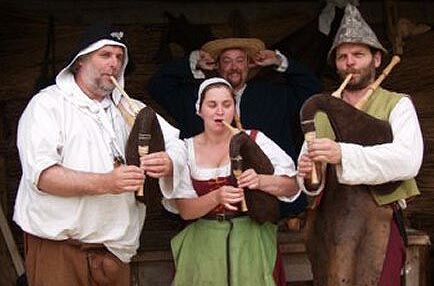
We must not forget the
nobility, nor, at the very least our Town Mayor,
or was he the Sheriff
or Bailiff in times past? Apart from the Mayor, there will be important
landowners and stallholders,
visiting gentry and other
nobles at the fair.
We intend to raise a Dais
at the fair, where dignitaries may meet,
to represent the Market
Hall. During the day various activities
will take place around
this ‘central board’, such as the paying
of market fees, and the
collecting
of tithes and fines. Music of the
more formal kind, court
dance, recitals, and official announcements
by the High Steward or
Town Crier will be made from here.
The Grand Opening and Closing
of the fair and the awarding of prizes
will also take place on
the Dais. The Mayor will of course open the Fair,
and his Insignia will
fly on a pole over the Dais ‘till the Fayre be done’.
We hope that the fair will
attract re-enactors from far and wide, not only wanting to participate
in this unique experiment, but also just visiting and adding to the colour
and atmosphere. Maybe they will purchase treasured items not seen elsewhere,
or just say ‘I was at Colchester’. Interest has already come from across
the UK and near Continent.
Here is an opportunity
to bring together the best historical interpreters and medieval artisans
in the country. Bring to Colchester the largest medieval fair and market
anywhere in Britain. Help to make it a reality. Join us in June and you
too can be part of this exciting event:
The
Oyster fayre 2003
Back
to the Bill of Fayre

